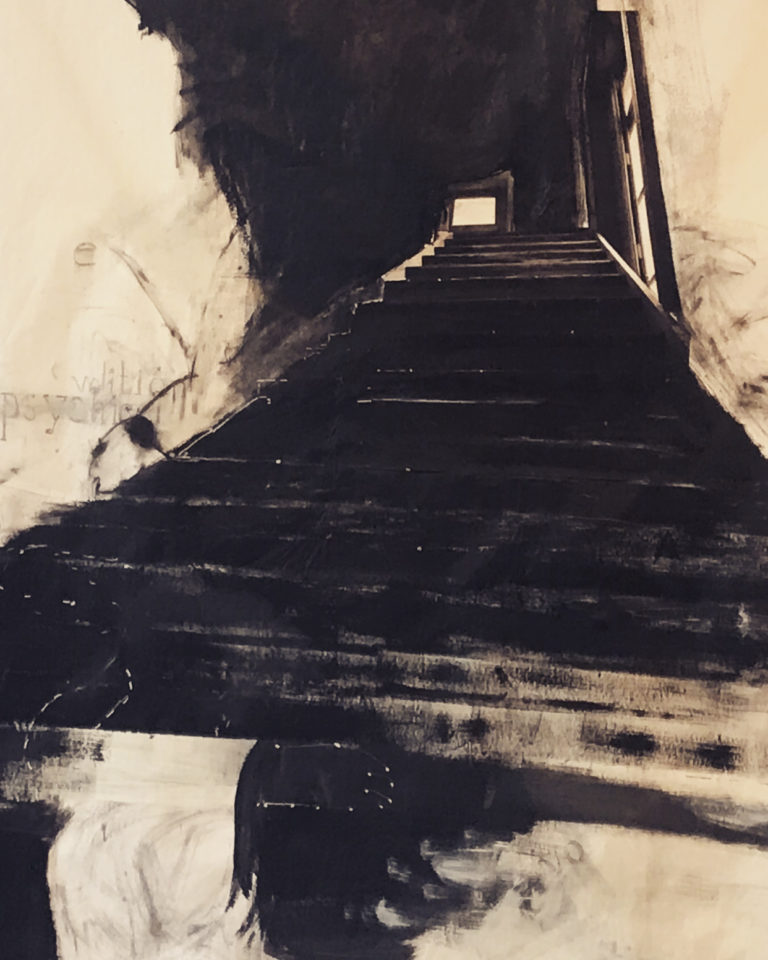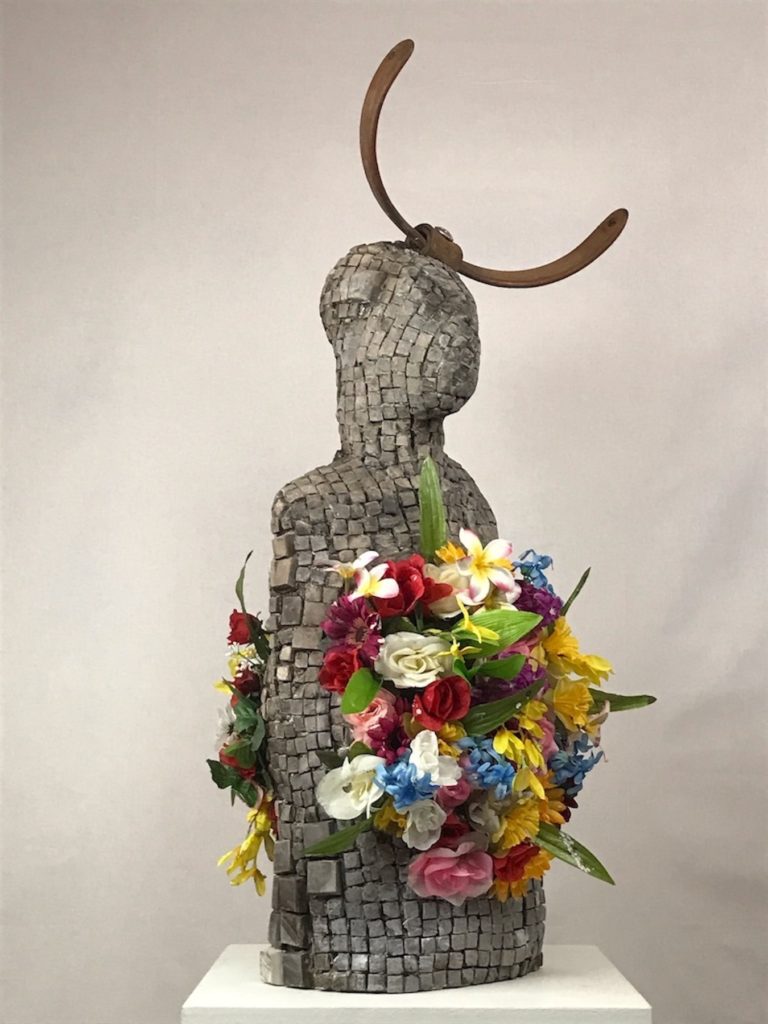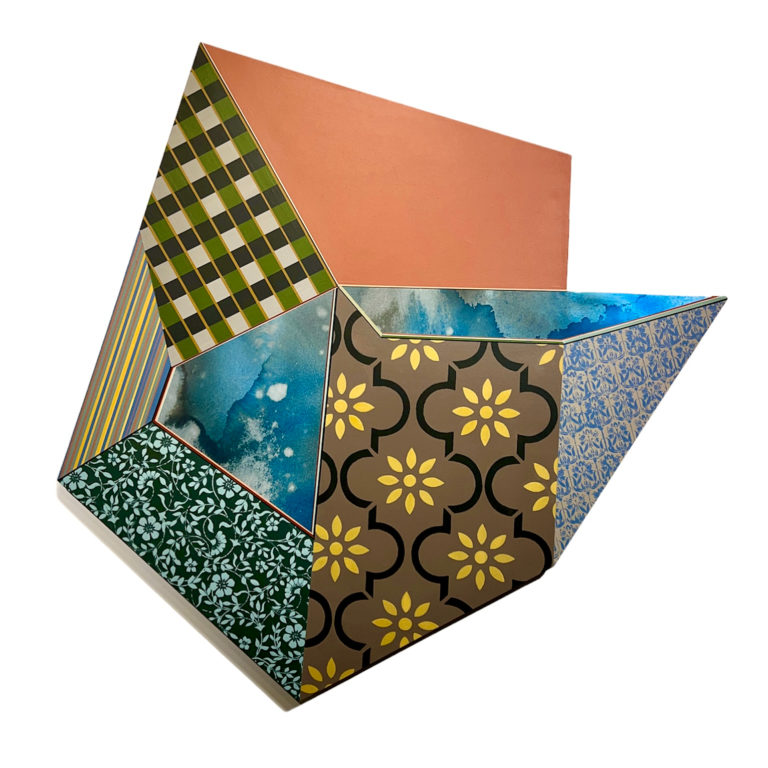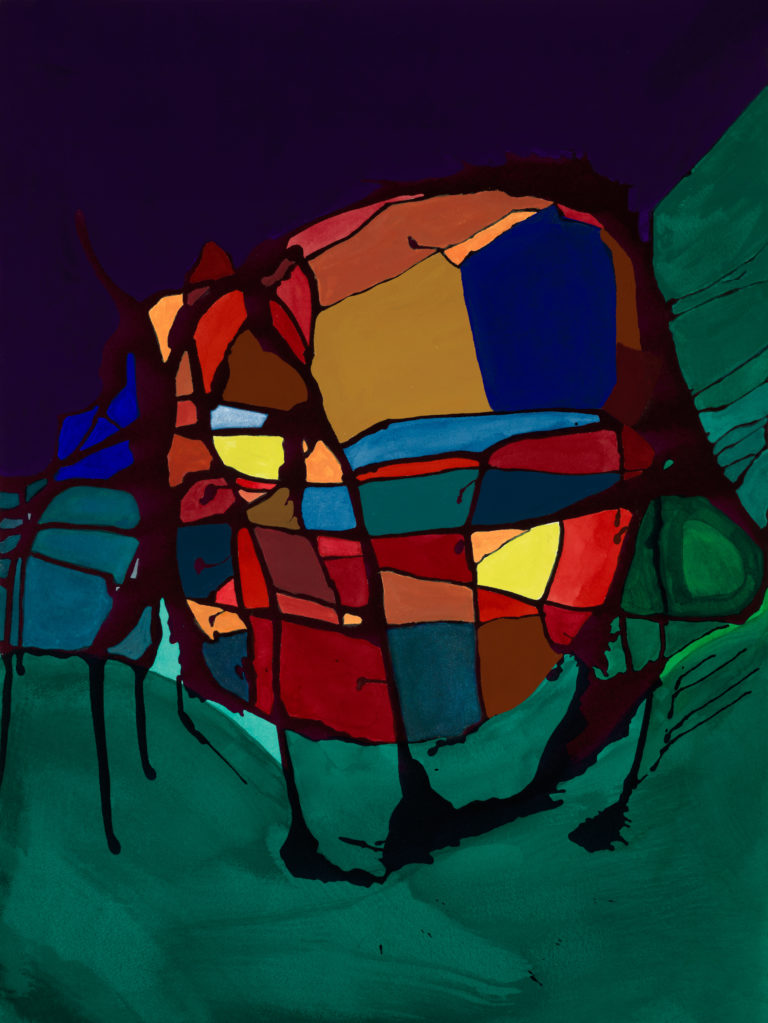
Spring 2023 Online Exhibition
About the Exhibition, by Perri Neri, Director
Let’s talk about space. Space is taught in geometry, physics, architecture, and even in psychology, with terms like “personal space” and “psychological space.” The artists in this exhibition possess a strong architectural and psychological presence in the spaces they inhabit.
Cynthia Sparrenberger’s arrangement of lines in Sleepwalker suggest elemental architectural forms, arranged with mysterious, undeniable purpose. We are directed toward something hopeful or pessimistic, an understanding that can quickly tilt from one to the other, depending on who is looking.
Set design, by its nature, is an amalgamation of many skills. Lindsay Maiorano finds the moment and supports it through interpretation and perspective, thought and sentiment, while considering an action unfolding in time. Each scene, captured through Maiorano’s photography, exists as a collaboration between artist and viewer.
Michael John Murray makes sculpture with a sense of humor and a sense of the serious absurdity of things. Murray tells stories through a combination of multiplex color-play and the eccentric, varied, truthful, and unpredictable experience of being human.
Nichole Gronvold Roller invites us into her personal space through her shaped works. There are windows to look through, deep and shallow areas to crawl into, and there are motifs and rhythms to follow. Our attention is drawn to the shaped supports, questioning the strength of the perceptual glue coupling the harmony and balance.
Bekka Teerlink is a painter of the flash of recognition here now in this moment. Her use of color unifies every corner, shifting and quivering with the desire to not be forgotten. Teerlink finds a kind of Proustian electricity in these personal and transient scenes that will leave a trace of the image clinging to our own memory.
Vian Borchert is an artist deeply engaged with the realm of poetry. Through the varied energy of mark-making lines and shimmering washes of color, these paintings are meant to exude feeling as we look and encounter them. They are paradigms, if not the harbingers, of what it means when we communicate with an artist through their work.
Leslie Ford’s Ball of Confusion series, lead us through physical, spatial, and spiritual realms to speculate on the metaphors of a circle contained within the square. Layers of transparent and opaque paint are offered as elements working together to create a rhythm of abstract curiosities like stardust, intergalactic matter, and gravity and time.
Gerri Rachins makes paintings that take on a multivalence as both abstractions and representations of abstractions. They are of desperate circumstances and discomforting situations. They are of scampering furry feet, of spindly smiles, of lights in windows, and solar systems. Everything mingles here in Rachins extraordinary way of bringing the intuitive and the accidental to the reasoned and purposed.
Janet Goldner’s abstract constructions of welded steel have a vintage aesthetic and a strength of interconnectedness that speaks to the artist’s international, intercultural, and multigenerational collaborations. With the negative spaces defined, the structures huddle together to gracefully hold their balance.
Beyond the surface of the collage, Rita Holcberg’s work speaks to a certain uneasiness of an experimental space, a place to try things, to take them apart and put them back together. Re-compositions crafted from dis-order, hold the idea of reclamation. Holcberg is pushing deeply into the personal, in no way simply on the surface.
Featured Artists: Vian Borchert, Leslie Ford, Janet Goldner, Rita Holcberg, Lindsay Maiorano, Mike Murray, Gerri Rachins, Nichole Gronvold Roller, Cynthia Sparrenberger, and Bekka Teerlink.
2021, Mixed Media
78 x 61 inches
Mixed Media Sculpture
84 x 42 inches
Mixed Media Sculpture
84 x 42 inches
Mixed Media Sculpture, photography
66 x 36 inches
Mixed Media Sculpture, photography
66 x 36 inches
Mixed Media Sculpture, photography
66 x 36 inches
Mixed Media Sculpture, photography
66 x 36 inches
2022, Concrete, wood, artificial flowers
39 x 15 x 15 inches
2022, Concrete, wood, acrylic
25 x 12 x 12 inches
2022, Concrete, wood, acrylic
25 x 10 x 8 inches
2022, Concrete, wood, acrylic
26 x 14 x 14 inches
2023, Concrete, polystyrene, acrylic
78 x 24 x 18 inches
2022, Acrylic and ink on shaped panel
27 x 29 inches
2022, Acrylic and ink on shaped panel
50 x 45 inches
2022, Acrylic and ink on shaped panel
48 x 44 inches
2022, Acrylic on canvas
20 x 16 inches
2022, Acrylic on canvas
30 x 30 inches
2021, Acrylic on canvas
30 x 24 inches
2022, Acrylic on canvas
30 x 24 inches
2022, Acrylic on canvas
30 x 30 inches
2022, Acrylic on archival paper
8 x 6 inches
2022, Acrylic on archival paper
8 x 6 inches
2022, Acrylic on archival paper
8 x 6 inches
2022, Acrylic on archival paper
8 x 6 inches
2022, Acrylic on archival paper
8 x 6 inches
2022, Oil pigment stick on panel
12 x 12 inches
2022, Oil pigment stick on panel
12 x 12 inches
2022, Oil pigment stick on panel
12 x 12 inches
2022, Oil pigment stick on panel
12 x 12 inches
2022, Oil pigment stick on panel
12 x 12 inches
2022, Flashe, acrylic ink on Arches Aquarelle paper,
30 x 22 inches
2022, Flashe, acrylic ink on Arches Aquarelle paper,
30 x 22 inches
2022, Flashe, acrylic ink on Arches Aquarelle paper,
30 x 22 inches
2022, Flashe, acrylic ink on Arches Aquarelle paper,
30 x 22 inches
2022, Flashe, acrylic ink on Arches Aquarelle paper,
30 x 22 inches
2021, Welded steel,
20 x 16 x 3 inches
2021, Welded steel,
22 x 30 x 3
2021, Welded steel,
14 x 30 x 3
2022, Welded steel,
20 x 22 x 5
2021, Welded steel,
22 x 24 x 8
2022, mixed media, watercolor, collage
20 x 14 inches
2022, mixed media, watercolor, collage
20 x 14 inches
2022, mixed media, watercolor, collage
20 x 14 inches
2022, mixed media, watercolor, collage
20 x 20 inches
2022, mixed media, watercolor, collage
20 x 20 inches













































